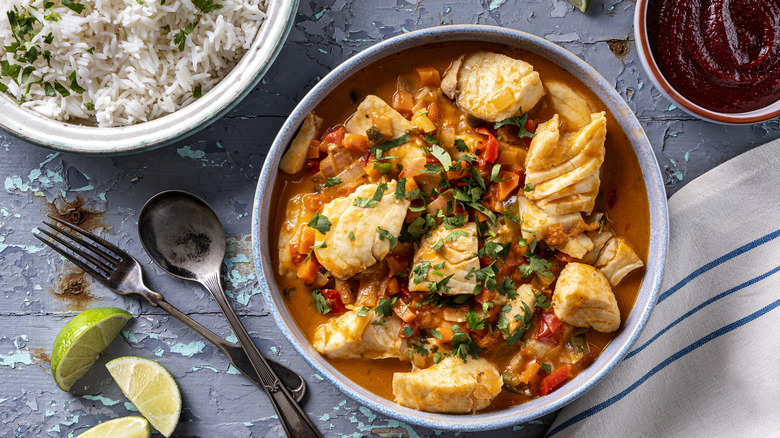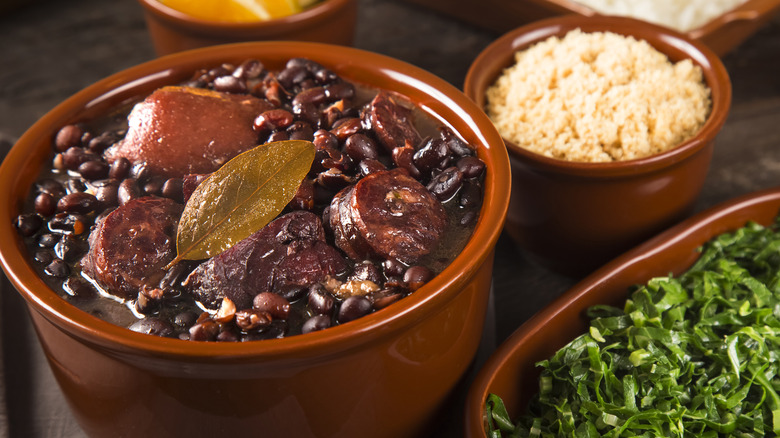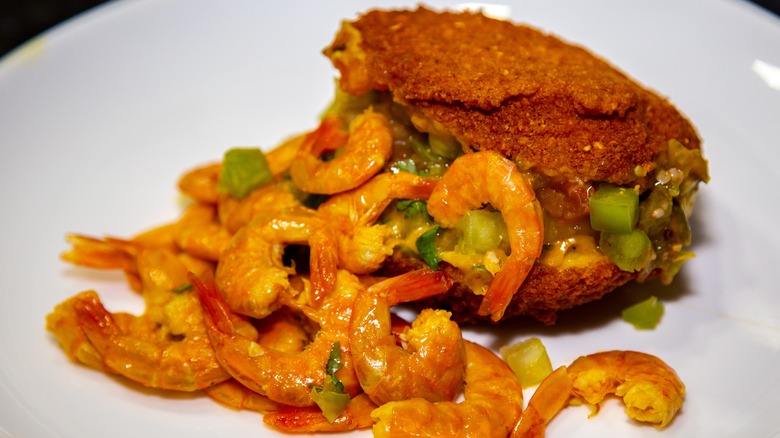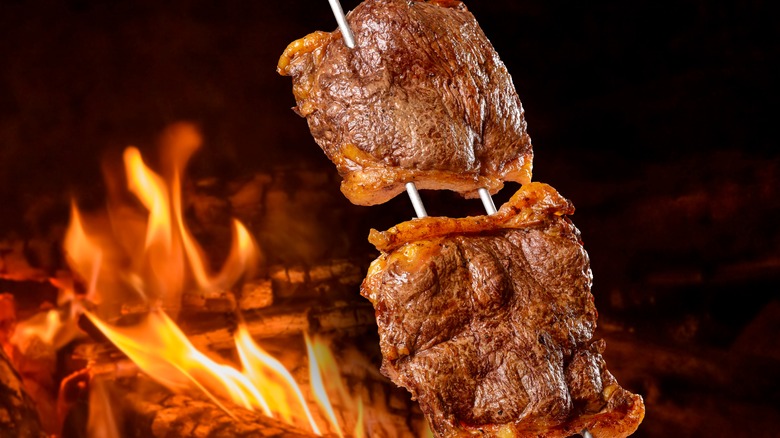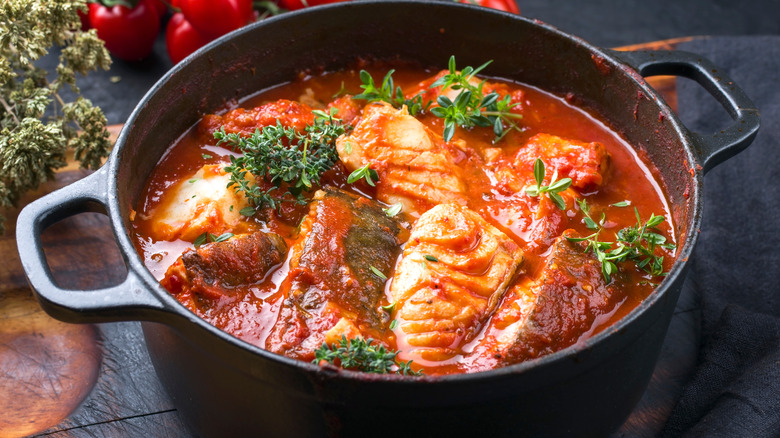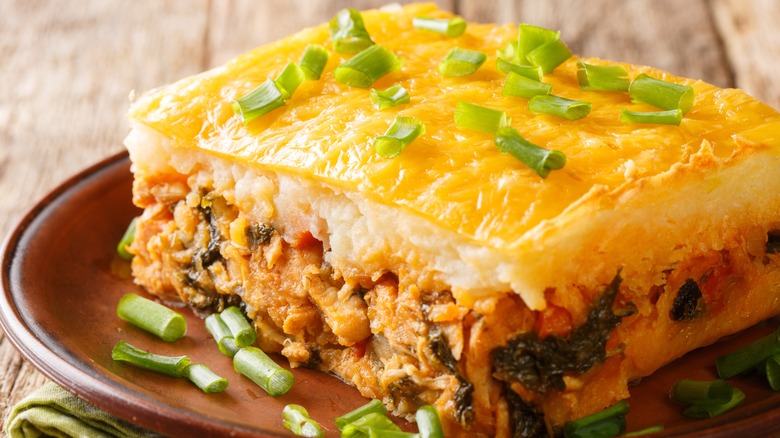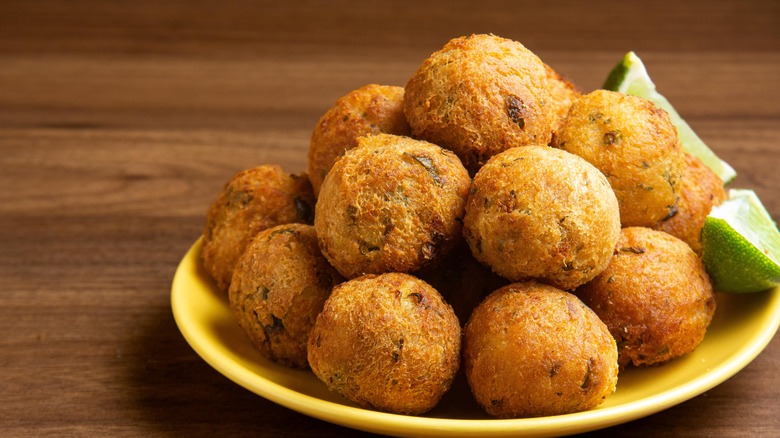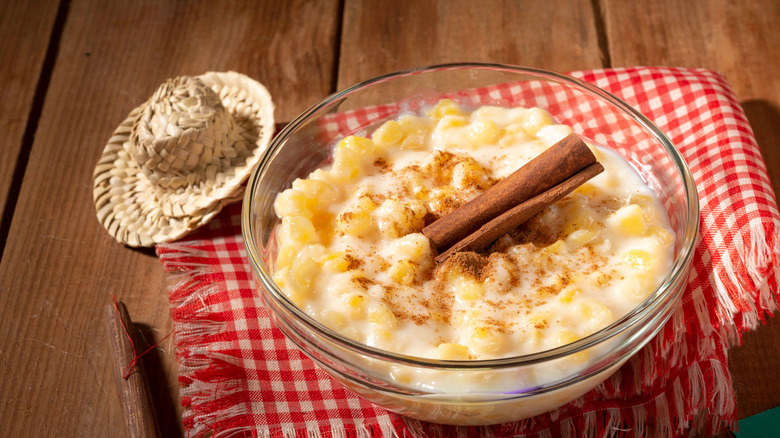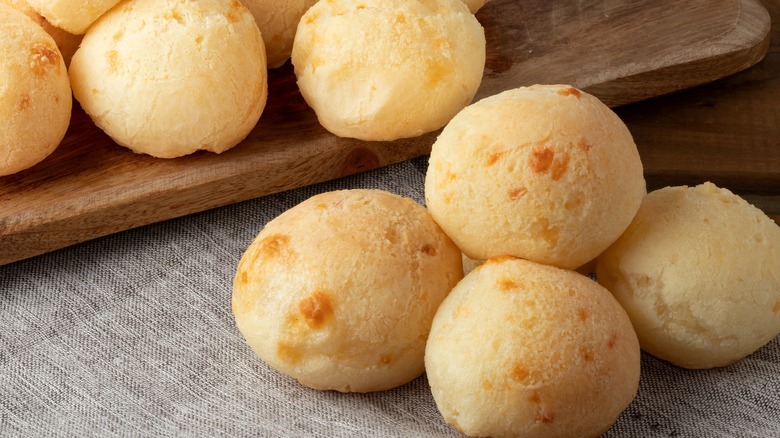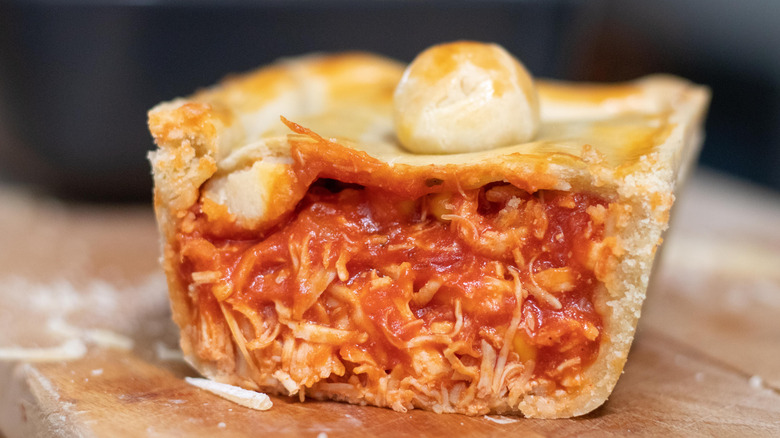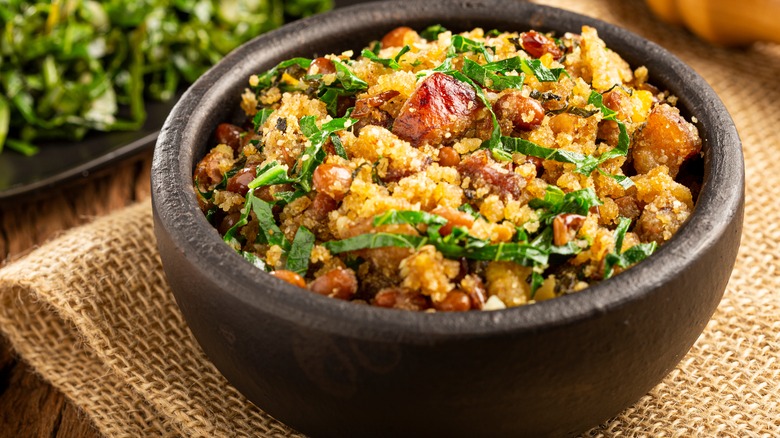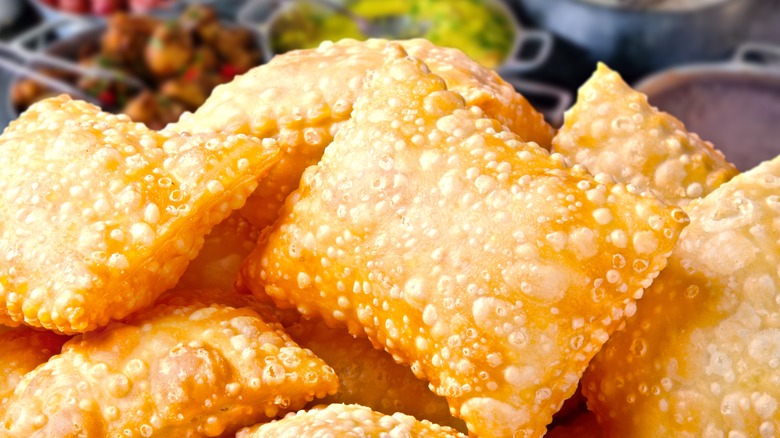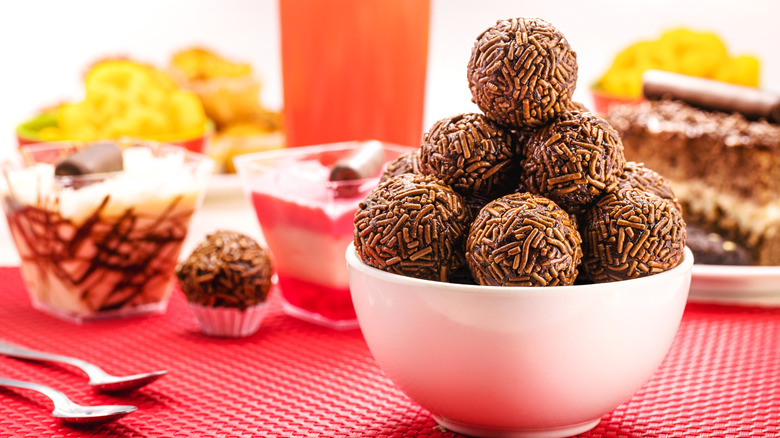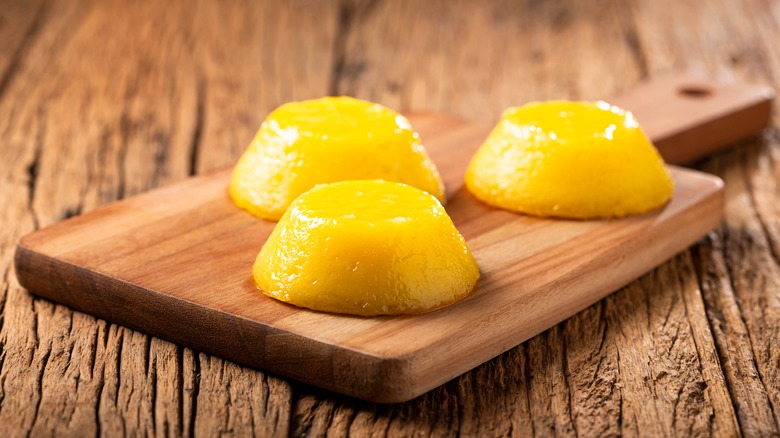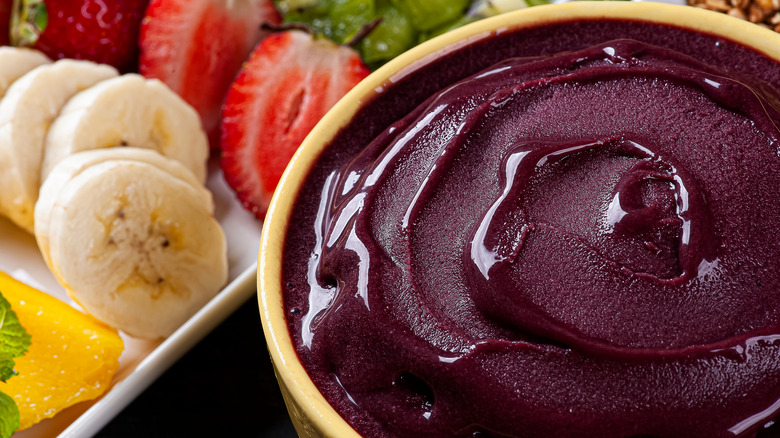14 Brazilian Dishes You Need To Try At Least Once
Brazilian food is so much more than steak. Sure, Brazilian steakhouses tend to pop up around the country as you're promised massive cuts as well as stacks of beef and pork. While beef certainly is a popular and important product throughout this region of South America (this includes Paraguay, Uruguay, and Argentina), Brazil has so many other incredible food offerings. For starters, it has an amazingly ecologically diverse nation. Stretching from the Amazon all the way to the Atlantic, there are fruits and vegetables here you've probably never seen before.
Combine that with the culturally robust population that combines aboriginal, Portuguese, Spanish, French, and a number of other backgrounds in one melting pot, and you'll discover Brazil has one of the most culinarily expansive profiles in the Western Hemisphere. So, whether you're planning a visit to Brazil or you're looking to recreate some of the traditional flavors of the South American nation, here are several of the most important Brazilian dishes you need to try.
Feijoada
If you haven't spent much time in South America, you might not realize just how important soups are. The majority of nations in the continent have their own unique soup, and Brazil is no exception. In Brazil, you're going to find a soup called feijoada.
Feijoada is more of a hearty stew pumped full of pork, beef, and beans. It's the kind of heavy stew you'd want to warm up to in the middle of a cold winter, although, in Brazil, you'll be slurping it as you watch some of the most beautiful people in the world walk the beachfront. Depending on where you are in the country, you will find all kinds of variations, ranging from shredded meat to pork sausage, although most will have a deep, brownish-black look. Feijoada soup has all kinds of cultural connections, with influences ranging not only from Portugal and pockets of Africa but India as well. Brazil is truly the multi-cultural melting pot of South America, and it is very evident in its food.
Acarajé
There's nothing like street food. There's just something about watching it fried up and prepared for you that is unlike anything else. Acarajé is basically a fritter, although it is made of chopped onions and black-eyed peas before it's smashed together, balled up, and deep-fried. Think of it as a Brazilian falafel, with black-eyed peas replacing chickpeas.
The food itself originated in West Africa and was brought to the Americas via the slave trade (you will find a great number of Brazilian dishes have origins in Africa). The West African version was called Akara, and while the spelling is different, many of the ingredients are the same. You will also encounter Akara when traveling in the Caribbean. However, acarajé has become a staple food in Brazil, so if you ever visit, this is absolutely a must-try menu item you need to gravitate to. You may also find other ingredients used as a stuffing between two pieces of acarajé.
Picanha
Here is some of that meat you've probably seen served up at Brazilian steakhouses. It is a steak cut from the rump of the cow and then skewered, which allows bits of the juicy meat to cook close to the fire. Traditionally it is cooked over a wood fire, although in the States, it might be charcoal (or, gasp, gas).
Picanha is an interesting type of cut of meat. If you went into a butcher in the United States and asked for this piece, they would likely look at you like you were nuts. However, it is a rather popular cut in Brazil, and you can also find it in Argentina, another major beef-producing country, with an even different name. (Funny enough, in Argentina, it is called "bief Americanos.")
If you were to ask for a picanha in the U.S., it would be called a top sirloin cap or a rump cap. Basically, take the edge of the top sirloin where there is a sliver of fat, and then cut the protein about an inch or so under the fat. So, you have a thick one to two inches of protein with a sliver of fat on top. This cut of beef is then skewered and grilled. The fat and muscle combo makes it easy to pierce as well as eat without much cutting once it has finished grilling.
Moqueca
Moqueca is a Brazilian fish stew. Some of the fish come from the ocean, and some of the fish come from the Amazon. It all depends on where you are in the country. It's also worth trying the stew wherever you visit because it'll be different wherever you go (you'll also find a similar fish stew in neighboring Amazon countries). The base idea of this soup originates in Angola, which is located in Southern Africa.
Typically, ingredients inside a bowl of moqueca stew include garlic, tomatoes, some onions, likely a squirt of lime, and other spices. The spice profile (as well as the kind of seafood used) is really what will vary from one location to the next. One thing to keep in mind, though. Many versions of moqueca include cilantro, so if you're someone who absolutely detests the taste, you should ask before ordering if it is included. You don't want your soup to taste like soap.
Escondidinho de frango com mandioca
Escondidinho de frango com mandioca is one of those food names that makes you wish you could read Portuguese, although maybe you learned Spanish in high school, and some of the words translate over. The food is a shredded chicken dish that is served under a cassava purée au gratin. Cassava is similar to a potato with a nutty, slightly sweet taste.
One way to remember this is as a Brazilian shepherd's pie. While you're replacing the traditional Irish ingredients with Brazilian, the concept is very much the same. You have the interior of the dish as shredded chicken, and then on top, you have a purée, which is like mashed potatoes with a hint of nutty sweetness (on a side note, if you've ever found cassava chips, do yourself a favor and pick them up. It is like a very earthy potato chip). As for escondidinho de frango com mandioca, it is typically made in a large, family-sized casserole dish, although some restaurants might serve the dish in an individual souffle bowl.
Bolinho de bacalhau
Think of bolinho de bacalhau as Brazilian hush puppies (only better). The balls of goodness take meat from fish (almost always cod, as bacalhau is Portuguese for cod), which then is balled up and deep-fried. Traditionally, bolinho de bacalhau is served as an appetizer, although we won't fault you if you chow down on these goodies as a main dish.
The cod is generally skinned, boned, and boiled. Once soft, it will then be mashed together with onion, potatoes, and egg, as well as different seasons (sometimes as simple as salt and pepper, other times there is garlic and additional spices included). Once everything is mashed together, the individual balls are fried crips. If you've spent a long day walking through Rio or visiting the beach and you need a quick boost of energy, ordering a basket of these is a great way to go, as you'll get a nice helping of both carbs and proteins, which can satisfy your hunger before you're ready for the next meal.
Canjica
Many cultures have their version of oatmeal. In Brazil, you're going to find canjica (depending on where you are in the country, it might also go by the name of mungunzá or mugunzá). This porridge carries white corn, which is then cooked and softened in a mixture of milk and coconut milk. Sometimes sugar is added, other times it's not, and then it's often topped off with cinnamon. This is a thicker, chunkier version of the oatmeal you're accustomed to making with corn instead of oats.
Numerous winter festivals take place in Brazil during the month of June. At this time, canjica is commonly served. You will find similar dishes in surrounding South American countries, such as Colombia and Argentina. However, the Colombian and Argentina versions are called mazamorra (there are similar variations found in Paraguay as well as the Caribbean, although other ingredients are used to sweeten the dish, such as honey, lemons, and raisins).
Pão de queijo
When traveling through South America, you will eventually discover that many of the regions have some variation of cheese bread. Pão de queijo is the Brazilian version. This food originated in the African slave communities in Brazil as it allowed for simple ingredients to be baked together. It used inexpensive ingredients to make a carb and protein-rich meal.
While individuals within the slave trade did create the dish, it is very specifically Brazilian. It is not a version of a dish that came over from Africa or Portugal. Originally, the dish started with enslaved individuals peeling cassava root, which was then made into bread rolls. Dairy in the form of cheese or milk was not added to the bread rolls until later. Some of the versions you might try will have a very sweet taste to them, which not only comes from the cassava but additional sugar. Similar versions around South America include chipa in Paraguay and pan de queso (cheese bread) in Colombia.
Empadão
Empadão is the Brazilian version of a pot pie. This pie is stuffed with meat, typically shredded chicken (although near the coastline, it might be stuffed with fish or shrimp), as well as various vegetables. It is then baked and served in slices.
The dish did originate in Portugal, although it took on a new life of its own once it became a popular dish in Brazil. The kind of stuffing used within the "pie" does vary greatly. If you're ordering empadão at a restaurant, make sure to look into what the meat stuffing is, as it can be anything from beef to cod, so there is a large spectrum of options. Empadão also typically has a kind of starch layered on top of the protein. This can come in the form of rice, mashed potatoes (or mashed cassava), or a regular bread crust. It is an essential, versatile, and robust Brazilian casserole.
Feijão tropeiro
When it comes to feijão tropeiro, there are many surprisingly similar ingredients to foods found in the Southeastern United States. Much of this is due to the African slave trade, specifically as traditionally African flavors began mixing with French and Portuguese colonists. You will find some similar tastes in parts of the Caribbean, too. Feijão tropeiroh is like a jambalaya without the rice. It's traditionally made with sausage (or bacon), beans, eggs, and collard greens.
Feijão tropeiro is generally found in the area around São Paulo. In this area of Brazil, there were large numbers of horses, known as troperio in Portuguese. Individuals working with the horses to herd them and break them in often ate these dishes while away from home. In a way, it is a Brazilian cowboy (gaucho) meal. Feijão is a Brazilian black bean, so the dish's name literally means cowboy beans.
Pastel
The pastel is essential to the Brazilian version of the empanada. This is another one of those food items you are going to find in nearly all of Latin America but with slight variations. Some are baked, others are fried, and the stuffing will change. In Brazil, the pastel (many of which have the shape of those old McDonald's apple pies and others with the more traditional empanada shape of a half-moon) are fried in vegetable oil and stuffed with all kinds of things.
Some are stuffed with cheese, others with ground beef and tomato sauce, and others with cream cheese, chicken, and lime. There are also sweet pastel versions, with some featuring guava and other fruits. Brazilian pastels are incredibly diverse, so if you're ordering them, make sure to ask what is inside. You don't want to bite down on a sweet jam version when assuming it'll be an egg.
Brigadeiro
In Brazil, brigadeiro is a type of chocolate truffle. They are going to be a bit sweeter than some of the European counterparts, and while Argentina might be best known among South American countries for chocolate (like peanut butter-filled Bon-o-Bon), you owe yourself a sampling by snacking on these little bits of heaven.
Brigadeiro are very uniquely Brazilian and made up of rather straightforward ingredients, including coca powder, condensed milk, and butter. The majority of these dessert balls are covered in chocolate sprinkles. If you're not a milk chocolate fan, there are other flavors available. White chocolate, as well as banana, are commonplace (with some topped with coconut flakes, nuts, and chocolate chips). In southern Brazil, the chocolate truffle is also referred to as negrinhos, but the flavor and ingredients are the same. So, if you are traveling north from Argentina or Uruguay into Brazil and you see this dessert listed on a menu, keep that in mind.
Quindim
In Portugal, there once was a sweet treat originally made using egg yolks and almonds. When the Portuguese came to what would become known as Brazil, they did not have almonds, so instead, they used coconuts. Now, Brazil has quindim, made up of egg yolk, coconut, and sugar.
Quindim is most commonly served in a small, individually sized dish, not all that different in size from a doughnut. However, larger variations can be made in a ring mold (think of one of those old Jello molds from the 50s). When quindim is made in a large mold that must be sliced and served in smaller portions, the dessert is referred to as a quindão.
Many of the Brazilian dishes on display in this list can be relatively easy to make, so even if you are unable to hop on a flight and fly down to the country, you should have access to many, if not all, of the necessary ingredients. This is especially the case with quindim, as you only need a handful, and in no time at all, you'll have an authentic Brazilian dessert.
Açai smoothie
A few years ago, acai berries started making waves on late-night infomercials thanks to the fruit's high antioxidant levels. Heck, you might have never even heard of antioxidants until these commercials started popping up. Everyone started proclaiming the acai berry as a "superfood." Well, why not go to the source of this superfood and have yourself a super smoothie?
Did you know the açai berry doesn't grow on a bush like other berries? Instead, it actually grows on a kind of palm tree. Known as the açai palm, long strands grow out of the tree, with deep black and purple fruit growing on the end. You probably wouldn't want to eat the berry right off the tree, though, as the majority of the fruit is made up of seed. The fruit is processed, and the seed is removed. Because the fruit is so small, all the natural sugars have nowhere else to go, so this is an incredibly sweet berry. Just keep this in mind when downing your açai smoothie because it is packed with calories (an açai bowl can have upwards of 1,000 calories from the fruit alone).
